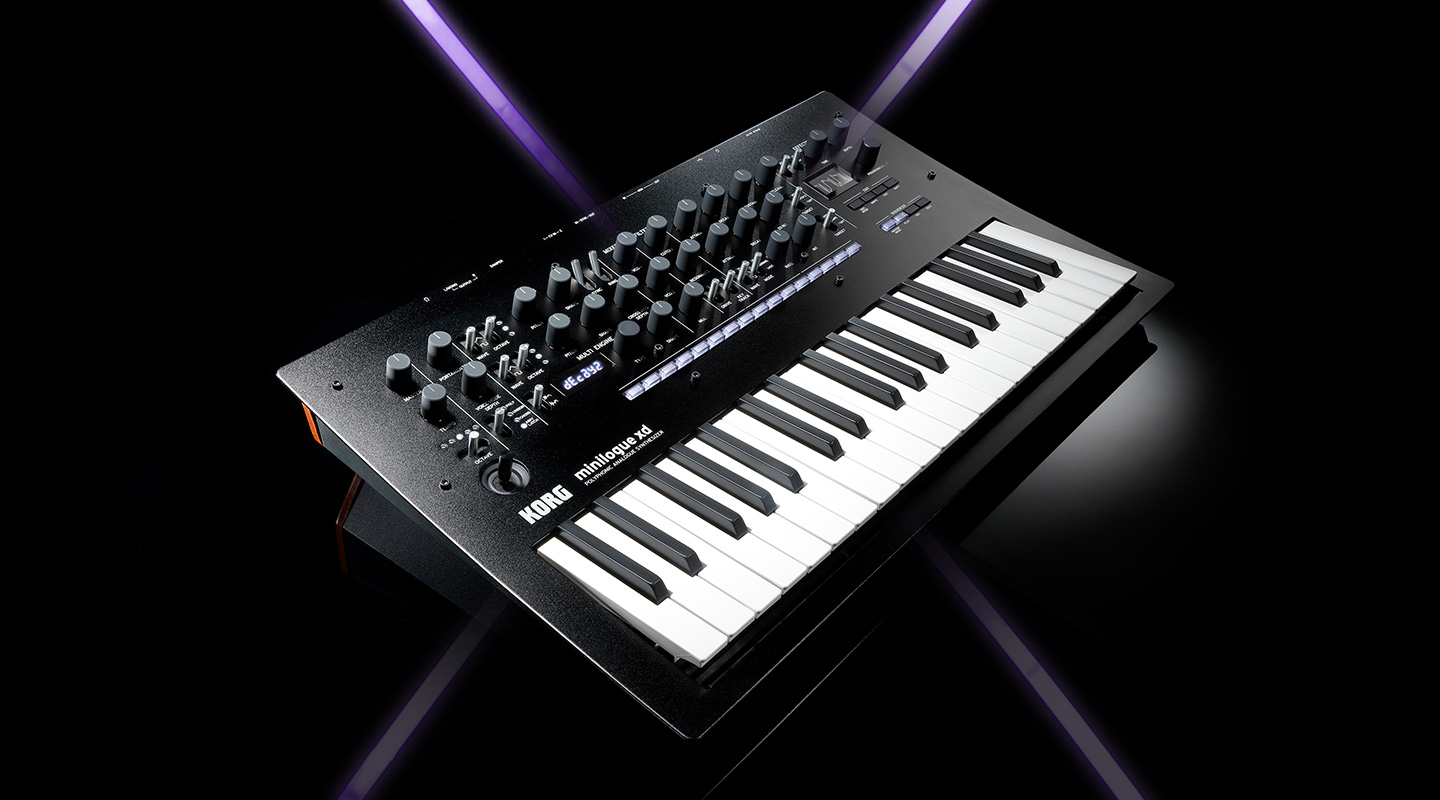
Review: Korg Minilogue XD
Korg has updated its popular Minilogue, adding new features including the Multi Engine oscillator and the Effects Engine from the Prologue series.
In 2016 Korg released the Minilogue, their first polyphonic analogue synth since the ‘80s. This compact four-voice synth won popularity thanks to sounding superb and being inexpensive. Two years later, Korg followed with their flagship analogue polysynths, the Prologue 8 and Prologue 16 with eight and 16 voices respectively. The Prologues introduced the concept of a ‘Multi Engine’: a third programmable digital oscillator open for third-party development, and they also had an Effects engine open for third-party development. The Minilogue xd harnesses the versatility of the Prologue’s Multi Engine and Effects engine, yet maintains the Minilogue form factor at a price that’s not too much more than the original.
The xd has inherited some of the cosmetics of the Prologue, with black knobs and a black faceplate, but maintains the unique curved form factor of the original Minilogue. As with its predecessor, the build quality is exceptional; the knobs are chassis-mounted and feel solid, providing high-resolution control of parameters where appropriate.
The OLED oscilloscope display, a hallmark of the original Minilogue, is now larger. The quirky diagonal performance lever from the original Minilogue has thankfully been retired and in its place is a dual axis joystick located just above the keyboard. A series of 16 buttons flank the centre of the panel providing hands-on interaction with the step sequencer and much-improved access to the sub pages of the menu system. Finally, the audio output of the Minilogue xd is now stereo instead of mono.
Korg has also released a desktop module version (Minilogue xdm) that will appeal to those looking for a more compact unit to take on tour. Korg added a new MIDI Poly Chain feature in a recent firmware update, providing an effective means of expanding the voice count by connecting additional units together via MIDI.
Straight out of the gate, Korg has made the Minilogue xd Sound Librarian application available (for MacOS and Windows) providing patch library management and the means for uploading third-party content for the Multi Engine and Effects.
The Voice Mode feature has been streamlined for the xd with its controls more intuitively located adjacent to the Oscillator section. The Poly, Unison, Chord and Arpeggio modes remain from the original. The Duo mode no longer has a dedicated mode, instead being integrated into Poly mode (in the latter range of the Voice Depth control). Also missing are the Note Delay (akin to a MIDI Note Chase effect) and the Sidechain modes.
OSCILLATOR SECTION
The dual VCOs provide pure analogue waveforms (Saw, Triangle and Pulse) modulated by a Shape parameter which is routed to the LFO. For the Saw and Triangle waves the Shape parameter invokes wavefolding, gradually increasing harmonic complexity. For the Pulse wave the Shape control tweaks the duty cycle, and modulating it via the LFO yields PWM. VCO1 and VCO2 both feature Ring Modulation, Sync and variable Cross Modulation.
For the xd, these VCOs are complemented by a digital Multi Engine oscillator identical to that of the Prologue series. It offers three modes: User mode allows one to import 16 third-party oscillators; VPM mode provides a wavetable synth with 16 wavetables plus a noise generator; and ‘Noise’ mode offers four types of noise. For all Multi Engine types, a simple Shape parameter is offered for front panel tweaking. An additional six parameters are found in the Program Edit menu.
NEED TO KNOW
Korg Minilogue XD &
XDM Polyphonic Analogue Synthesizers
The User mode is of the greatest interest. The first of its 16 slots is preloaded with Waves by Korg. At the time of reviewing the Prologue, third-party Multi Engine oscillators were yet to emerge. Since then, a small but growing core of developers has stepped up to the plate. Thankfully oscillators developed for the Prologue will import to the Minilogue xd. [Refer to ‘Third-Party Multi Engines & Effects’ for links.]
For the sake of the review, I installed the Freeware oscillators offered by Peter Allwin and Jason Long. Exploration of these oscillators immediately showed how much the Multi Engine expands the sound palette, with many being rich in harmonic content. These additional oscillators inspired many new patches, and in several cases I even found it unnecessary to have the analogue VCOs layered to get satisfying tones with plenty of movement.
The highlight for me was Jason Long’s developments; in particular, his Chips 2.0 oscillator which brings vintage digital game console sounds into play. He has been quite prolific of late, having released an additional two effect algorithms, Bucket and Hera, and also a preview video of a custom wavetable/sample import tool he has in development with full key-range mapping and more: https://tinyurl.com/yxbw3h6k
With the sheer number of new oscillators I’ve discovered so far, it was apparent that having 16 slots for third-party oscillators may soon become a limitation. It’s important to note that swapping algorithms in and out of the synth will break patches unless the same oscillator types are loaded back into the correct slot number, because patches reference oscillators based on the slot they’re loaded into rather than by name.


FILTER SECTION
The VCF is a two-pole (12dB/octave) low pass filter making use of Operational Transconductance Amplifiers (OTA). It has a rich, powerful and consistent sound when swept across the audible frequency spectrum, and is capable of self-oscillation. The cutoff frequency can be modulated in a bipolar manner from the EG or LFO. New for the xd (and just like the Prologue), the filter now features a drive stage offering two preset amounts of drive: 50% and 100%. VCF keyboard tracking can be engaged at 50% or 100%. With resonance at self-oscillation, you’ll find the key tracking is scaled to be in tune (great for high resonance white-noise leads).
The four-pole mode of the original Minilogue is absent for the xd, fueling speculation that Korg has repurposed the filter circuit from the Prologue for the Minilogue xd. Notwithstanding, to my ears it sounds slightly different.
MODULATION MATRIX/SOURCES
The modulation matrix is basic, nevertheless the essentials are there to create ample movement. The xd has two envelopes: a traditional ADSR (hardwired to the VCA), and a simple AD routed to either VCF Cutoff or the pitches of VCO1 or VCO2. A single LFO is provided capable targetting one of either VCO Pitch, VCO Shape or VCF Cutoff at a time. There are additional LFO destination options in the menu, where it can target specific oscillators. (The multi-engine shape parameter has its own dedicated envelope also hidden in a menu.)
On the back panel, you’ll find dual CV inputs designed to interface with Eurorack hardware. For those seeking more expansive modulation options than those available internally, you can easily integrate all manner of exotic modulation sources from your Eurorack modular synth. There is a total of 29 different modulation targets available for the CV1 and CV2 inputs. Additionally, the upward and downward travel range of the Joystick’s Y-axis may be independently mapped to the same list of 29 modulation targets.
EXPANDED (& EXPANDABLE) EFFECTS
The original Minilogue’s effect engine was a mono bucket-brigade analogue delay that was a touch primitive and noisy. The effects section has been vastly overhauled for the xd, inheriting the same lush-sounding stereo DSP Effects Engine of the Prologue series.
The first slot provides Modulation effects: Phaser, Flanger, Chorus, and Ensemble. The second and third slots offer Reverb and Delay respectively. Only the Rate and Depth parameters are available to tweak – all other parameters are hardwired in various factory presets. While each algorithm sounds excellent and the presets are well-appointed, like anything preset, I did crave the ability to tweak further.
Similar to the Multi Engine oscillator, additional effect algorithms can be installed with 16 slots for the Modulation FX and eight slots each for Reverb/Delay effects. At this point, I can’t help but recall the excitement of loading third-party effects into my Ensoniq EPS16+ and ASR10 samplers back in the ‘90s. A brief run-down on what is available is covered in ‘Third-Party Multi Engines & Effects’.
ARPEGGIATOR & SEQUENCER
Like its predecessor, the Arpeggiator is implemented as a feature within the Voice Modes, rather than being an independent entity, and now features a Latch function. Thirteen arpeggiator modes are available on the Voice Depth control with some even providing polyphonic modes, which is a nice touch. Rather than a dedicated octave span setting, you’re limited to what is predetermined within these modes. The decision to implement the Arpeggiator within the Voice Modes means it’s not possible to have arpeggiated patches with the unison engaged simultaneously.
A polyphonic Sequence can be attached to each patch memory independently and may have up to 16 steps. Sequences can easily be entered in step mode or recorded and overdubbed in real-time alongside a metronome. A powerful Motion sequence feature allows capture of knob movements for up to four parameters simply by recording movements during playback. It’s also possible to have Motion sequences defined without having any note data in the sequencer, effectively providing four beat-synced, 16-stage looping envelopes – a useful means to extend the modulation facilities of the synth.
Because the VCO levels can be automated, it’s possible to simulate complex multitimbral sequences by bringing different VCOs and/or the Multi Engine in and out of the mix on different steps. This is further enhanced by the fact the Multi Engine can be set to bypass the VCF within the menus. The possibilities are capably demonstrated in a video tutorial by BoBeats, here: https://tinyurl.com/y3lgnx55.
My only real disappointment is that Sequences can’t be transposed in real-time by striking notes on the keyboard as part of a live performance; which is a missed opportunity because that’s the essence of making step sequences really come to life.
I had issues with the Sync Source setting in the Global Edit menu providing only ‘Auto’-based settings for slaving to external clocks, either via MIDI or USB. For example, if you are playing the Arpeggiator (Latched) whilst slaved to MIDI clock and you stop the transport, the unit assumes you no longer want to use an external clock and, after a brief moment, resumes playback. Hopefully, Korg considers adding non-auto sync options.
CONCLUSION
The Minilogue xd packs a punch in terms of features, considering its size and price. Far from being a mere incremental feature bump, the Minilogue xd is a substantial refresh of the original concept – so much so that it really is a different synth: sounds created on the original Minilogue cannot be imported into the Minilogue xd because the architecture differs too much.
Despite its limited modulation options, after exploring what the Multi Engine oscillator adds it’s clear that the Minilogue xd is capable of a sound palette far beyond a dual VCO synth. Once you program your own patches to taste and think inventively to achieve movement within sounds, it really sings. The icing on the cake is the inclusion of the Prologue’s Effects engine; on the original Minilogue it was difficult to evoke really big lush sounds without using an external effect unit, but with a few knob twists and switch flips in the Effects section of the Minilogue xd you’ll quickly find yourself in sonic nirvana.
It was effortless to coax everything from angular aggressive digital basses and snarling dirty leads through to floaty sublime keys and pads. I found myself inspired to create new patches every time I had a session with it. If you’re in the market for a modern four-voice polyphonic analogue synth with the extra fruit that only hybrid digital synths can provide, the Minilogue xd is definitely worth checking out.






















RESPONSES